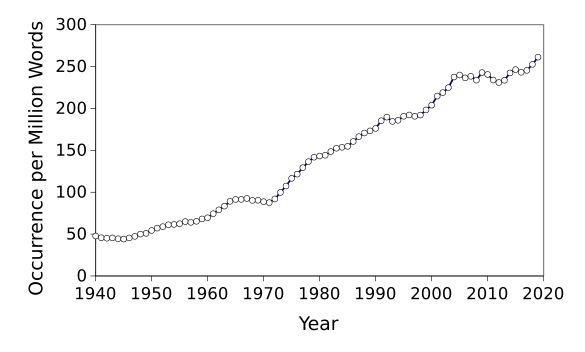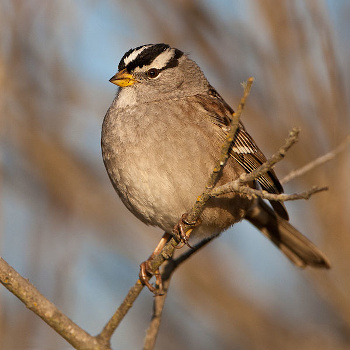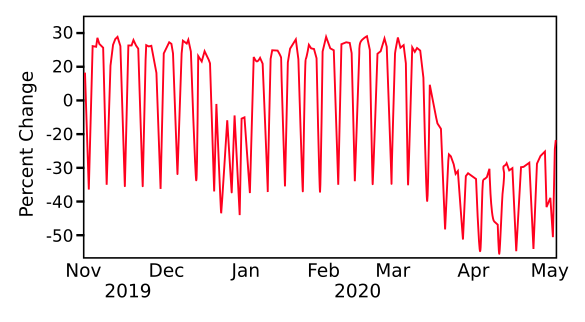Noisy Civilization
November 16, 2020
City-dwellers who retreat to the
suburbs envision an existence away from
ubiquitous sirens and loud
traffic noise that assault their
tranquility at all times of the day. However, they're disappointed when they discover that the city noise sources have been replaced by similarly
annoying lawn mowers,
leaf blowers, and
snow blowers. Along with these
acoustic noise sources come the increased
noise-to-signal ratio that limits reception of their former favorite
broadcast radio and
television stations. We live in a
noisy civilization.
You can do an
A-B test of civilization noise by retreating to the
wilderness on
vacation. Fortunately,
Tikalon's Northern New Jersey location is less than an hour's travel from some reasonably secluded venues, and a few hour's travel to some real wilderness in
New York State. As they say, there can be
too much of a good thing, and that includes
silence. There's a
cautionary tale about an avid
reader who had a
soundproof reading room constructed in her house so noise wouldn't distract from her reading. After a few minutes in the room, she would invariably fall
asleep.
One strange noise source is "
The Hum," a persistent
low-frequency humming/
rumbling noise reported by some people. The most famous of these hums is the "
Taos Hum" of
Taos, New Mexico. Observers of the Taos Hum reported hearing the noise between 32-80
Hz in frequency,
amplitude modulated from 0.5-2 Hz. A
New Zealand researcher,
Tom Moir, a
computer engineer then at
Massey University, recorded a New Zealand hum at 56 hertz.[1]

Frequency of occurrence of the word, "Hum," from 1940-2019. (Via Google's NGgramViewer.)
Although
heavy machinery is a likely source for this noise, few of the reported hums have been traced to any such source. One noise source was definitely identified with a large
pump, and a 35 Hz hum in
Windsor, Ontario, Canada, ceased when a
steel plant there closed in April of this year.[2] Large
electrical distribution power transformers have also been cited as a possible source, since
transformer core materials will
vibrate with the
electric current. Another
culprit is the vast
network of underground pipelines.
Just as the
events of September 11, 2001, gave scientists in the United States the
opportunity to examine the reduction in diurnal temperature caused by
aircraft contrails,[3] the
worldwide economic slowdown caused by the
COVID-19 pandemic and its resultant worldwide quieting has given another research opportunity.
Biologists and
mathematicians from the
University of Tennessee (Knoxville, Tennessee),
California Polytechnic State University (San Luis Obispo, California),
Texas A&M University–San Antonio (San Antonio, Texas), and
George Mason University (Fairfax, Virginia) have recently
published a study that found that one example of
birdsong improved in this quiet
environment.[4-5]
The specific
species studied was the
white-crowned sparrow (Zonotrichia leucophrys), which has a standard
tune that starts with a few
whistles, and ends with a series of complex
trills.[5] Previous research showed that sparrows sing at a louder
amplitude in a noisy environment, straining to be heard, and this resulted in a
lower-quality song.[5] There was an expectation that the birdsong would improve during the pandemic's
shelter-at-home mandates and economic slowdown.[4-5]

A white-crowned sparrow (Zonotrichia leucophrys).
(Wikimedia Commons image by Mike Baird, Morro Bay, California)
Because of the pandemic, vehicle traffic in the studied areas of
San Francisco and
Contra Costa County, California, were reduced to the level of the mid-
1950s.[4] The study team expected that this quieting would affect the sparrows' song, but they were surprised by how much.[5] Says lead
author of the study,
Elizabeth Derryberry, an
associate professor at the University of Tennessee, Knoxville, "The songs didn’t change as much as we predicted - they changed even more... It highlights just how big of an effect noise pollution has."[5]
The birds reacted to their newer, quieter, environment by producing higher quality songs at lower amplitudes.[4] All this is important to
male birds, who use their songs to find
matess and defend their
territory.[5] In the quieter environment, the songs of
urban birds travelled about twice as far.[4-5] Bird calls in the
rural setting of nearby
Marin County were essentially unchanged by the pandemic.[4-5] The study demonstrated that an the birds have an inherent resilience to noise pollution, and they can adapt rapidly in response to favorable conditions.[4]
There's no data about the reaction to pandemic quieting by
bees, but there has been a study about how the
Earth, as a whole, reacted. A global quieting of high-frequency
seismic noise was detected by a huge international team from 66 research institutions.[6-7] This study, led by
Thomas Lecocq of the
Royal Observatory of Belgium (Brussels, Belgium), is published as an
open access paper in a recent issue of
Science.[6]
Human activity creates high-frequency seismic waves that are detected as a nearly continuous
signal, especially on
seismometers in urban areas.[6] Not surprisingly, these signals are typically stronger during the day than at night, weaker on
weekends than weekdays, and weaker at the
Christmas and
New Year's holidays where they are
celebrated.[6] Mitigation actions to limit the coronavirus (COVID-19) pandemic resulted in a month's long reduction in seismic noise of up to 50%.[6] The quieting of
seismicity began in
China in late January 2020, followed by
Italy, the rest of
Europe, and the rest of the world in March to April 2020.[6]

Temporal changes in global daily median high frequency seismicity as reported by the 185 stations that observed lockdown effects. Percentage changes are expressed relative to a prelockdown baseline. The weekday-weekend difference, the COVID-19 pandemic quieting, and the usual year-end holiday slowdown can be seen. (Created using Inkscape from data in Fig. 4a of Ref. 6.[6] Click for larger image.)
References:
- Mysterious humming driving Aucklanders 'bonkers', New Zealand Herald, October 27, 2006.
- Stephen Hutcheon, "Mystery humming sound captured," The Sydney Morning Herald, November 17, 2006.
- David J. Travis, Andrew M. Carleton, and Ryan G. Lauritsen, "Contrails reduce daily temperature range," Nature, vol. 418, no. 6898 (August 8, 2002), p. 601, https://doi.org/10.1038/418601a.
- Elizabeth P. Derryberry, Jennifer N. Phillips, Graham E. Derryberry, Michael J. Blum, and David Luther, "Singing in a silent spring: Birds respond to a half-century soundscape reversion during the COVID-19 shutdown," Science (September 24, 2020, Article eabd5777, DOI: 10.1126/science.abd5777. This is an open access article with a PDF file here.
- Carrie Arnold, "When the pandemic quieted San Francisco, these birds could hear each other sing," National Geographic, September 24, 2020.
- Thomas Lecocq, et al., "Global quieting of high-frequency seismic noise due to COVID-19 pandemic lockdown measures," Science, vol. 369, no. 6509 (September 11, 2020), pp. 1338-1343, DOI: 10.1126/science.abd2438. This is an open access article with a PDF file here.
- Marine A. Denolle and Tarje Nissen-Meyer, "Perspective - Seismology, Quiet Anthropocene, quiet Earth," Science, vol. 369, no. 6509 (September 11, 2020), pp. 1299-1300, DOI: 10.1126/science.abd8358.
Linked Keywords: City-dweller; suburb; ubiquitous; siren (noisemaker); roadway noise; traffic noise; tranquility; annoyance; annoying; lawn mower; leaf blower; snow ; acoustic noise; signal-to-noise ratio; noise-to-signal ratio; broadcasting; broadcast; radio broadcasting; television station; noise; noisy; civilization; A/B testing; A-B test; wilderness; vacation; Tikalon; Morris County, New Jersey; Northern New Jersey; New York State; too much of a good thing; silence; cautionary tale; reading (process); reader; soundproofing; soundproof; reading room<; sleep; The Hum; frequency; low-frequency; humming; rumble (noise); rumbling; Taos Hum; Taos, New Mexico; hertz; Hz; amplitude modulation; amplitude modulated; New Zealand; research; researcher; Tom Moir; computer engineer; Massey University; frequency of occurrence; word; Hum; NGgramViewer; heavy equipment; heavy machinery; pump; Windsor, Ontario, Canada; steel mill; steel plant; electrical distribution power transformer; transformer core; material; vibration; vibrate; electric current; culprit; pipeline transport; network of underground pipelines; events of September 11, 2001; September 11, 2001, climate impact study; reduction in diurnal temperature; aircraft contrail; COVID-19 recession; worldwide economic slowdown; COVID-19 pandemic; biologist; mathematician; University of Tennessee (Knoxville, Tennessee); California Polytechnic State University (San Luis Obispo, California); Texas A&M University–San Antonio (San Antonio, Texas); George Mason University (Fairfax, Virginia); scientific literature; publish; bird vocalization; birdsong; environment (biophysical); species; white-crowned sparrow (Zonotrichia leucophrys); melody; tune; whistling; whistle; trill (music); amplitude; quality; stay-at-home order; shelter-at-home mandate; Wikimedia Commons; Mike Baird; Morro Bay, California; San Francisco; Contra Costa County, California; 1950s; author; Elizabeth Derryberry; associate professor; male; mating; mate; territory; urban area; rural area; Marin County, California; bee; Earth; seismic noise; Thomas Lecocq; Royal Observatory of Belgium (Brussels, Belgium); open access journal; open access paper; Science (journal); Human; signal; seismometer; workweek and weekend; Christmas; New Year's Day; holiday; celebration; seismic wave; seismicity; People's Republic of China; Italy; Europe; time; temporal; median; COVID-19 pandemic lockdown; baseline; Inkscape.